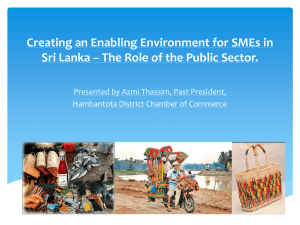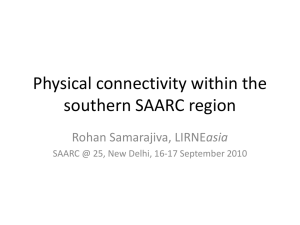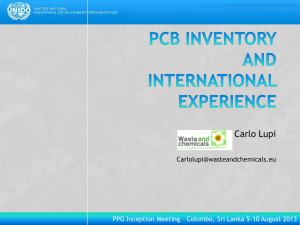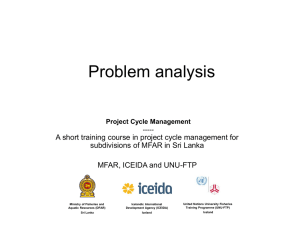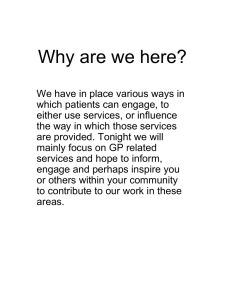PCB Management in Indonesia
advertisement
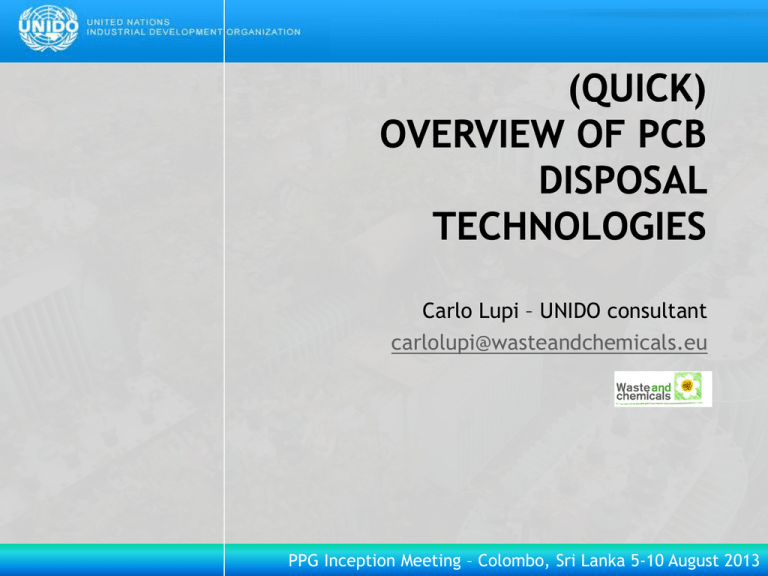
Carlo Lupi – UNIDO consultant carlolupi@wasteandchemicals.eu PPG Inception Meeting – Colombo, Sri Lanka 5-10 August 2013 PPG Inception Meeting – Colombo, Sri Lanka 5-10 August 2013 ….sorry – any question? PPG Inception Meeting – Colombo, Sri Lanka 5-10 August 2013 PPG Inception Meeting – Colombo, Sri Lanka 5-10 August 2013 Thermal technologies Chemical technologies Post Treatment Pretreatment Incineration Sodium based dechlorination Solvent Washing Draining Co-Incineration (Cement kiln) Hydrodehalogenation Retrofilling Shredding Thermal desorption Vacuum extraction Plasma Vacuum washing PPG Inception Meeting – Colombo, Sri Lanka 5-10 August 2013 Oil Thermal technologies Transformers Capacitors Thermal technologies Pre treatment Cleanup of carcasses Thermal technologies Post treatment Post-treatment or thermal technologies Other waste (paper, wood, soil) Thermal destruction Thermal desorption followed by thermal destruction PPG Inception Meeting – Colombo, Sri Lanka 5-10 August 2013 New transformers Old transformers Capacitor (very rare) Chemical dehalogenation Pretreatment (draining, flushing) Pretreatment (draining, dismantling) Draining or shredding Oil reprocessing Chemical dehalogenation (of the oil) Chemical dehalogenation Chemical dehalogenation or incineration Retrofilling Post treatment Thermal treatment of the waste Oil Recovery of scrap metal PPG Inception Meeting – Colombo, Sri Lanka 5-10 August 2013 Regulatory level for equipment and dieletric oil •Stockholm Convention: <50 ppm •National regulations: <2ppm to <50 ppm Other uses by sector •Burning oil: (40 CFR 761.20) <2ppm (if greater only incineration is allowed) •Unused oil: not detectable (IEC 60296 / IEC 61619) Environmental standards •Cleanup level for soils (from 0.1 ppm to 15 ppm) POPs waste •Low POPs content: <50 ppm (cann be landfilled) •High POPs content: >50 ppm (cannot be landfilled) PPG Inception Meeting – Colombo, Sri Lanka 5-10 August 2013 Article 6.1(d)(ii) of the Stockholm Convention on POPs requires that Stockpiles of POPs and waste contaminated by POPs must be • “destroyed or irreversibly transformed” • otherwise disposed of in an environmentally sound manner (low POPs content) • In compliance with all other national and international rules PPG Inception Meeting – Colombo, Sri Lanka 5-10 August 2013 Designed to prevent or to reduce releases of chemicals listed in Part I of Annex C (PCDD/F, HCP and PCB and their impact on the environment as a whole.) Destruction of PCBs must not result in the release of Dioxins!! PPG Inception Meeting – Colombo, Sri Lanka 5-10 August 2013 DE • ((Input mass – Sum of ALL outputs)/Input mass)*100 • >99,99% DRE • ((Input mass – mass released in the atmosphere) / input mass)*100 • >99.9999% PPG Inception Meeting – Colombo, Sri Lanka 5-10 August 2013 Trial burn with PCB contaminated soil (PCB 1-2%) Trial burn with PCB oil (PCB 20%) Trial burn with PCB soil and capacitors (PCB 10%) DE / TEq test trial burn with PCB soil and capacitors (PCB 10%) PPG Inception Meeting – Colombo, Sri Lanka 5-10 August 2013 Pre-treatment (including meshing, shredding, feeding) may be an important source of release. It may also represent a risk for workers (exposure to chemicals and other accidents) Pre-treatment equipment and operations must be properly designed to avoid human exposute and prevent release of toxic wate PPG Inception Meeting – Colombo, Sri Lanka 5-10 August 2013 No matter how good is the downstream disposal technology… If the pre-treatment is poorly managed, it will result in the release of POPs (low DE) PPG Inception Meeting – Colombo, Sri Lanka 5-10 August 2013 Demonstrably safe Inherently safe • A technology that achieves the highest possible level of occupational safety and has a history of safe operation. • Closed system of the technology as a whole (pretreatment + destruction process) PPG Inception Meeting – Colombo, Sri Lanka 5-10 August 2013 EIA, IPPC (BAT compliance) Building permits and land use Licensing (waste handling, transportation) Monitoring of releases in atmosphere and water Environmental monitoring PPG Inception Meeting – Colombo, Sri Lanka 5-10 August 2013 Main reactions / Description PCB Concentration Process temperature Process pressure Reagents By products, outflows and waste streams Applicability Needs for post or pre treatment Main advantage Main limitations Technologies based on the use of metallic sodium to dechlorinate the PCB molecules. Generally not suitable for pure PCB 100° - 200° Atmospheric Metallic sodium. Sludge, Oils The process requires the dewatering and degassing of the matrix to be treated. Short time. Oil may be reused after treatment. Hazardous substances (Metallc sodium explodes when in contact with water) PPG Inception Meeting – Colombo, Sri Lanka 5-10 August 2013 Supplier Arochlor type Amount PCB (tons) Moles PCB Moles Cl Moles Na Cl (tons) Na (tons) Na consumption declared Reaction efficency Nacl produced BiPhenils produced Waste (sludge) Technology A 1242 1 3883 11649 11649 0.41 0.27 0.41 Technology B 1254 1 3063 15318 15318 0.54 0.35 0.93 65.09 0.68 0.60 1.28 37.90 0.90 0.47 1.37 PPG Inception Meeting – Colombo, Sri Lanka 5-10 August 2013 PPG Inception Meeting – Colombo, Sri Lanka 5-10 August 2013 PPG Inception Meeting – Colombo, Sri Lanka 5-10 August 2013 PPG Inception Meeting – Colombo, Sri Lanka 5-10 August 2013 PPG Inception Meeting – Colombo, Sri Lanka 5-10 August 2013 Main reactions / Description PCB Concentration Process temperature Process pressure Main Reagents The process consists of mixing and heating the contaminated media with the APEG reagent. During heating, the alkali metal hydroxide reacts with the halogen from the contaminant to form a non-toxic salt; and the PEG takes the location in the PCB molecule formerly occupied by the halogen making it less hazardous. Process can be operated in batch or continuous mode. Reported up to 45,000 ppm. – usually not suitable over 2000 ppm. 70° - 200° From atmospheric to 3.5 bar (CDP) Alkali metal hydroxide; polyethilene glycol; (APEG), Hydroxide tetraethilene glycol (ATEG), non alkali metal, polyalkeneglycol and a alkali or alkaline earth metal hydroxide or alcoholate. (SEA Marconi CDP process) By products, Mainly non toxic salts, and muds; be to when the process is used for the decontamination of outflows and transformer, the oil containing de-halogenated aromatics compound is re-used into the waste streams transformer; in the case of soil decontamination, de-halogenated aromatic compounds form a non hazardous waste to be further destroyed or incinerated. Applicability PCBs Oils; transformers containing PCB oils; soil. Needs for post or It may be necessary in the case of treatment of contaminated soil or wastes. pre treatment Main limitations Following EPA (US EPA, 540/S-93/s 506), and regarding the soil treatment, the disadvantages of the conventional APEG processes are that it often takes numerous cycles of the process to achieve the desired results, the process only effects partial dehalogenation, and the formation of dioxin and furans often occurs when the process is implemented” PPG Inception Meeting – Colombo, Sri Lanka 5-10 August 2013 PPG Inception Meeting – Colombo, Sri Lanka 5-10 August 2013 PPG Inception Meeting – Colombo, Sri Lanka 5-10 August 2013 PPG Inception Meeting – Colombo, Sri Lanka 5-10 August 2013 Main reactions / Description PCB Concentration Process temperature Process pressure Main Reagents Applicability Needs for post or pre treatment Main limitations Under the category of hydrodehalogenation may be included all the reductive dehalogenation processes involving the breaking of a single bond between a carbon atom and the halogen with the subsequent formation of a single bond between hydrogen and carbon. The process may involve the use of molecular hydrogen, similarly to the hydrogenation of crude oil, or may be based on processes of catalyzed transfer of hydrogen from an hydrogen donor. Usually up to around 5000 ppm. Pressure and process temperature depend greatly on the type of process adopted. The use of molecular hydrogen require temperature in the order of 350°C and high pressure. Process based on hydrogen transfer are performed at temperature ranging from 200 to 350 °C atmospheric pressure. Hydrogen or a hydrogen donor; catalyst; phase transfer agent; Soil, PCB oils. Pretreatment is needed if soil or contaminated devices are treated; Hydrodehalogenation processes are often operated at high temperature and pressure, requiring complex plants. PPG Inception Meeting – Colombo, Sri Lanka 5-10 August 2013 Process Description PCB Concentration Combustion in presence of an excess of oxygen Usually less than 15% PCB in the waste fed to the plant Main Reagents Chemicals for the treatment of the exhaust gases; By products, outflows Ashes; flue gases; secondary reagents after the flue and waste streams gas treatment Applicability Any kind of waste may be treated Needs for post or pre Depending on the incinerator type. treatment Main advantage Highly flexible; capable to deal with any kind of hazardous waste; consolidated technology. Main limitations High energy requirement. Sophisticated air pollution control system is needed to reduce PCDD/F emissions. PPG Inception Meeting – Colombo, Sri Lanka 5-10 August 2013 PPG Inception Meeting – Colombo, Sri Lanka 5-10 August 2013 PPG Inception Meeting – Colombo, Sri Lanka 5-10 August 2013 PPG Inception Meeting – Colombo, Sri Lanka 5-10 August 2013 Trial burn test 1 (PCB contaminated soil, PCB 1-2%) – PCDD/F 0.104 ngTEq/Nm3 Trial burn test 2 (PCB oil, PCB 20%) – PCDD/F 0.042 ngTEq/Nm3 Trial burn test 3 (PCB soil+capacitors, PCB 10%) – PCDD/F 0.080 ngTEq/Nm3 • Minimize release of POPs from the whole process !! Site cleanup Transportation and Storage Final Disposal PPG Inception Meeting – Colombo, Sri Lanka 5-10 August 2013 Process Description PCB Concentration Main Reagents By products, outflows and waste streams Applicability Needs for post or pre treatment Main advantage Main limitations Thermal destruction in the absence of oxygen Up to pure PCBs Inert gases Syngas; Chlorinated salts Liquid waste (oil) Depending on the plasma type. Reduced volumetric emission; very high process temperature High electric energy requirement. May require a system for the cleaning and storage of syngas PPG Inception Meeting – Colombo, Sri Lanka 5-10 August 2013 Parameter Main scope of the plant Capacity (t/hr) Maximum power Max current and voltage Type of plasma Type of reactor CSM Mobile Plasma for solid waste Mainly pulverized or granulated solids (asbestos); suitable for semisolid waste or liquid waste. 0.3 1MW 2000A, 500V Transferred arc, computerized design plasma torches Cylindrical reaction chamber (1mx1m) Batch / continuous process Batch (continuous for liquids) Operation temperature in Over 1700°C the destruction zone Flue gas flowrate (m3/hr) 500 Nm3/h Mobile / Transportable / Transportable Fixed PACTTM System for mixed waste Solids in drums; suitable also for semisolid, pulverized or granulated waste PLASCON liquid waste unit 0.2 (based on the duration of the whole cycle) 0.135 (for pure PCBs) Only liquids and gases 150KW Multimodal torch (nonTransferred for heating up, transferred for melting waste) Centrifugal chamber (1m3) Non transferred arc, in flight destruction of waste. Continuous Continuous 1650°C 3100°C Fixed 0.5 Nm3/hr Mobile “In flight” tube. PPG Inception Meeting – Colombo, Sri Lanka 5-10 August 2013 PPG Inception Meeting – Colombo, Sri Lanka 5-10 August 2013 Process description PCB Concentration Process temperature Process pressure Main Reagents By products, outflows and waste streams Applicability Needs for post or pre treatment Main advantage Main limitations Technology based on the physical replacement of contaminated dielectric oil in transformers with new dielectric oil. Not limited by concentration but the cost increases with increasing PCBs concentration. From ambient temperature to around 100°C, depending on the type of technology adopted. May be carried out at ambient pressure or under vacuum. None The main waste stream is the replaced oil that need to be decontaminated or destroyed.. Transformers and capacitors with high residual value, not at their end of life. Large transformers with low PCB contamination. None. Simple process very effective for low contaminated transformers . Not a stand alone technology. Requires further process for the subsequent destruction of PCBs. PPG Inception Meeting – Colombo, Sri Lanka 5-10 August 2013 Decontamination trends with retrofilling, starting from different concentrations. For pure PCBs, at least 6 cycles are required to bring PCBs contamination below 50 ppm 1000000 100000 10000 1000 100 10 1 0 1 2 3 4 5 6 7 8 Number of retrofilling cycles PPG Inception Meeting – Colombo, Sri Lanka 5-10 August 2013 Process description Technology based on the partition of chemical species between two immiscible phases. PCB Concentration Not limited by concentration but the cost increases with increasing PCBs concentration. Process temperature Process pressure Main Reagents By products, outflows and waste streams Applicability May vary with the type of process considered. Critical solvent temperature processes require a variable temperature during the process. May be conducted at ambient pressure (standard solvent processes); high pressure (near critical temperature solvent process) or under vacuum (solvent extraction in autoclave). Organic solvents. Different waste streams (contaminated oil, debris, water, sludge, metal scraps) may be generated during the pre-treatment steps. The use of volatile solvent may require a careful control of the atmospheric emissions. The outflow of a solvent extraction system is typically a concentrated extract of PCB, which has to be destroyed. Transformers and capacitors at their end of life; contaminated soils and wastes. Needs for post or Pre treatment of contaminated wastes is necessary (opening of the capacitors and transformers pre treatment carcasses; meshing and fracturing of the soil, etc.) After the extraction, concentrated PCBs must be stored and destroyed. Main advantage Flexible process capable of treat any kind of media. Main limitations Not a stand alone technology The use of solvents may require an high level of safety countermeasures to prevent exposure of workers. PPG Inception Meeting – Colombo, Sri Lanka 5-10 August 2013 PPG Inception Meeting – Colombo, Sri Lanka 5-10 August 2013 PPG Inception Meeting – Colombo, Sri Lanka 5-10 August 2013 Process Description Physical desorption of PCB by means of heating in presence of vacuum or a carrier gas. PCB Concentration Up to 10000 ppm in soil; Equipment carcasses contaminated with pure PCBs Main Reagents Carrier gas for the removal of PCB; solvents By products, outflows and Pure PCBs is extracted from the solvent after waste streams decontamination; sludge contaminated by PCBs; VOCs Applicability Contaminated soil and PCBs contaminated carcasses Needs for post or pre Treatment of the off gases (scrubbers, fabric treatment filters, condenser); Main advantage Consolidated technology; Main limitations High energy requirement; high moisture content may be a limitation to the process PPG Inception Meeting – Colombo, Sri Lanka 5-10 August 2013 PPG Inception Meeting – Colombo, Sri Lanka 5-10 August 2013 PPG Inception Meeting – Colombo, Sri Lanka 5-10 August 2013 ….Questions ? PPG Inception Meeting – Colombo, Sri Lanka 5-10 August 2013

